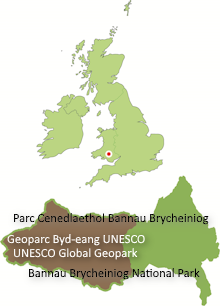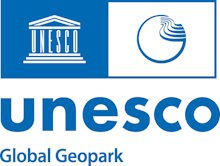The Carboniferous Limestone (Cil yr Ychen/Dowlais Limestone, the Penderyn Oolite and the Penwyllt Limestone) has been exploited since the Middle Ages. It was burnt to make lime mortar for building and to provide a flux for smelting metals. Powdered limestone (agricultural lime) is used to neutralise acid soils, improve drainage and provide chemical nutrients for crops.
The concentration of limekilns in the Geopark dates from the 18th and 19th centuries when lime was in great demand first for agriculture, for construction and later for the rising iron and copper industries. Coal provided the main fuel for burning lime during this time. In earlier periods charcoal was used in lime burning, and the use of wood would have had an impact on the remaining woodland in the area.
Lime mortar
In traditional construction techniques, lime would be ‘slaked’ i.e water added and with added sand gives a lime mortar used to bind stones of a wall together and perhaps also to provide a surface rendering.
What is a flux?
A flux is used in both the iron and copper-making processes to get rid of impurities such as silica (SiO2) First the limestone (mostly CaCO3) is burnt (‘calcined’) in a kiln to form quicklime (CaO). This is added to the iron ore and reacts with the silica to form calcium silicate (‘slag’) which is then separated off from the molten iron or copper.
CaO (quicklime) + SiO2 (silica) -> CaSiO3 (calcium silicate /’slag’)
Copper smelting
The requirement for limestone on a large scale as a flux in the smelting industries of South Wales was initiated by the development of copper smelting in the lower Swansea valley. Copper smelting began in the Swansea and Neath districts in 1717 and the Swansea area was established as a copper smelting centre by 1720. By 1778 copper smelting at Swansea was regarded as Britain’s major industry and Swansea remained the world centre for copper production until 1920. Quarries in the Geopark area, particularly at the Cribarth, supplied limestone as a flux for the copper smelting industry.
Iron smelting
In 1759 John Wilkinson together with his partners began to smelt iron at Merthyr Tydfil on the southern edge of the Geopark. The initial use of charcoal for this purpose was replaced in the second year of production by coke under the direction of John Guest, the company manager. In 1763 Anthony Bacon developed the great Cyfarthfa Ironworks. Bacon was succeeded by Richard Crawshay and under his leadership the improved puddling process for producing wrought iron – the Welsh method – revolutionised the industry. The industrial belt which developed along the northern rim of the South Wales coalfield required limestone as a flux in the smelting process. This demand was met by quarries within the Geopark.
Where was it quarried?
Both large and small quarries are scattered along the line of the limestone outcrop within the Geopark as it extends from Llandyfan in the west across the Black Mountain to Craig-y-nos in the upper Swansea Valley, then east again via Ystradfellte towards the Taf where it is offset by the major Neath Disturbance. It picks up again at Pontneddfechan and stretches east through Penderyn and Cefn-coed-y-cymer to Pontsticill at the southeast corner of the Geopark.
Major quarries included those at the Black Mountain Quarry complex north of Brynaman, at Penwyllt, Penderyn and just outside the area at Pontsticill. The remains of important smaller workings are still to be seen at Carreg yr Ogof, Carnau Gwynion (near Ystradfellte), Dinas Rock and Cadair Fawr amongst other places.



